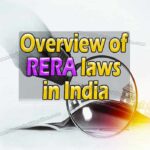Introduction
The passing of the Transfer of Property Act (for short TPA) was necessitated by the lack of any statutory law in India to govern real estate. The Courts adopted English law as the rule of justice, equity and good conscience. But due to different social conditions, that too proved to be inadequate to decide disputes coming up before the courts in India.
As a result, conflicting decisions were given by different courts on many issues. A law commission was appointed to remedy the situation. The Law Commission drafted a bill to provide for a code of substantive law for the Transfer of properties in India. The bill was successively referred to a select committee, subsequent law commissions etc. and finally, it came into force as the Transfer of Property Act, 1882 (4 of 1882).
Meaning of property
The word “property” is derived from an Anglo-Norman French variant of the Old French word during the Middle English era, that is, “propriete”. It comprises a set of rights recognised by law and has a title on it. The title-holder who enjoys the aforesaid rights could either be an individual or a group of people like an organisation. Properties are also transferred from one entity to another. The title gets transferred depending upon the contract. It is an act where a lawfully recognised entity either an individual or an organisation to anyone either in present or future.
Immovable Property [Section 3]
Sec.3:- “immovable property” does not include standing timber, growing crops or grass.
There is no definition as such given in the Transfer of Property Act, of the term ‘immovable property’. Section 3 of the Act merely states that “immovable property” does not include standing timber, growing crops or grass. In the absence of an exhaustive definition in the TPA definitions other enactments can be usefully referred to.
The term is defined in Section 3(26) of the General Clauses Act to include land, benefits to arise out of the land, and things attached to the earth, or permanently fastened to anything attached to the earth.
Things Attached to the Earth
As per Section 3 of the Transfer of Property Act, “attached to the earth” means –
- rooted in the earth, as in the case of trees and shrubs;
- embedded in the earth, as in the case of walls or buildings; or
- attached to what is so imbedded for the permanent beneficial enjoyment of that to which it is attached.
Rooted in the earth
Things like trees and shrubs which are rooted in the earth are regarded as ‘things attached to the earth’.
In the case of Shantabai v. State of Bombay[i]– As explained by the Allahabad High Court, “In the larger definition of “immovable property” anything attached to the earth would normally be treated as immovable property and a tree which is attached to the earth and seeks its nourishment and sustenance from the soil in which it stands will be deemed to be attached to the earth with the only distinction that if it was a tree of a kind which is usually used as timber and was of sufficient size so as it could be used as such and is intended to be severed from the soil reasonably thereafter, it may be treated to be immovable property.
Movable Property
The term ‘movable property’ is also not defined in the Transfer of Property Act. As per the definition given in the General Clauses Act ‘property of every description except immovable property’ is movable property. The Registration Act defines the term to include property of every description excluding immovable property but including standing timber, growing crops and grass. Thus, property of any kind whatsoever, which is not the immovable property is to be treated as movable property.
It will thus be seen that the definition of “moveable property” is negative and all that is not included within the meaning of “immovable property” shall be treated to be “moveable property”[ii].
“The distinction between moveable and immovable property was explained by Holloway, J., in an old Madras case Sukry Kurdepa v. Goondakull[iii] as follows: Movability may be defined to be a capacity in a thing of suffering alteration of the relation of place, immovability incapacity for such alteration. If, however, a thing cannot change its place without injury to the quality by which it is, what it is, it is immoveable. Certain things such as a piece of land are in all circumstances immovable. Others such as trees attached to the ground are, so long as they are so attached immoveable; when the severance has been effected they become moveable[iv].”
Examples of property which is not immovable property are-
- Electricity[v]
- Right of worship
- Government promissory notes
- Royalty,
- A decree for arrears of rent
What Property may & may not be transferred? [Section 6]
Sec.6:- Property of any kind may be transferred, except as otherwise provided by this Act or by any other law for the time being in force.
- The chance of an heir-apparent succeeding to an estate, the chance of a relation obtaining a legacy on the death of a kinsman, or any other mere possibility of a like nature, cannot be transferred.
- A mere right of re-entry for breach of a condition subsequent cannot be transferred to anyone except the owner of the property affected thereby.
- An easement cannot be transferred apart from the dominant heritage.
- An interest in property restricted in its enjoyment to the owner personally cannot be transferred by him.
(dd) A right to future maintenance, in whatsoever manner arising, secured or determined, cannot be transferred.
- A mere right to sue cannot be transferred.
- A public office cannot be transferred, nor can the salary of a public officer, whether before or after it has become payable.
- Stipends allowed to military, naval, air-force and civil pensioners of the government and political pensions cannot be transferred.
- No transfer can be made (1) insofar as it is opposed to the nature of the interest affected thereby, or (2) for an unlawful object or consideration within the meaning of section 23 of the Indian Contract Act, 1872 (9 of 1872), or (3) to a person legally disqualified to be transferee.
- Nothing in this section shall be deemed to authorize a tenant having an untransferable right of occupancy, the farmer of an estate in respect of which default has been made in paying revenue, or the lessee of an estate, under the management of a Court of Wards, to assign his interest as such tenant, farmer or lessee.
Exceptions to Section 6
Certain exceptions are stated in section 6 itself. These are as follows:
According to section 6 (a), the following cannot be transferred:
* the chance of an heir-apparent succeeding to an estate,
* the chance of a relation obtaining a legacy on the death of a kinsman, or
* any other mere possibility of a like nature.
Competence to Transfer, Operation of Transfer & Oral Transfers [Section 7]
The section states who is competent to transfer property as well as the extent to which he can transfer property.
Competence
A person is competent to transfer property if-
- he is competent to contract AND
- he is entitled to the transferable property OR if he is not the owner, he is authorized to dispose of the transferable property.
Competent to Contract: A person is competent to contract if he satisfies the conditions mentioned in section 11 of the Indian Contract Act.
Age of Majority: The transferor must have attained the age of majority according to the law to which he is subject. In India, therefore, a person who has not attained the age of 18 years is not competent to be a transferor. Where a guardian (other than a guardian ad litem) has been appointed for a person by a court of justice or where the superintendence of his property has been assumed by any Court of Wards the age of majority is 21 years. Since a contract by a minor is void[vi], a transfer made by a minor is also void.
Sound Mind: The transferor must be a person of sound mind. According to Section 12 of the Indian Contract Act, which defines ‘sound mind’ to contract, a person is said to be of sound mind to make a contract if, at the time when he makes it, he is capable of understanding it and of forming a rational judgment as to its effect upon his interests.
Conditional and absolute transfers- construction of deeds [Section 8]
Under section 8, only that interest which the transferor is capable of passing is passed on to the transferee. The general principle embodied in Section 8 is that, a grant prima facie carried with it all the legal incidents thereof, but that it may be modified according to the wish of the parties, the maxim being “modus at conventio vincunt legem” – the form of agreement and the convention of parties overrule the law. Where a grant does not carry with it all the legal incidents thereof but is modified by conditions and restrictions, it is a conditional or restricted transfer. Where however it carries with it all the legal incidents thereof, it is an absolute transfer.
Conditions restraining alienation [Section 10]
Conditions which restrain further alienation of property are void. Section 10 of the Transfer of Property Act provides as follows:
Where property is transferred subject to a condition or limitation restraining the transferee or any person claiming under him from parting with or disposing of his interest in the property, the condition or limitation is void, except in the case of a lease where the condition is for the benefit of the lessor or those claiming under him; provided that property may be transferred to or for the benefit of a woman (not being a Hindu, Muhammadan or Buddhist), so that she shall not have power during her marriage to transfer or charge the same or her beneficial interest therein.
Rule against Perpetuity [Sections 14 & 18]
Section 14 of the Act enacts the Rule Against Perpetuity or the Rule Against remoteness. The section is worded thus- No transfer of property can operate to create an interest which is to take effect after the lifetime of one or more persons living at the date of such transfer, and the minority of some person who shall be in existence at the expiration of that period, and to whom, if he attains full age the interest created is to belong.
According to Jarman, “A perpetuity in the primary sense of the word is a disposition which makes property inalienable for an indefinite period.” When a property is transferred involving generation after generation, perpetuities are said to be created.
The rule against perpetuity is founded on the principle that the liberty of alienation shall not be exercised to its destruction and that all contrivances shall be void which tends to create perpetuity or place property forever out of the reach of the exercise of the power of alienation[vii].
Lis Pendens [Section 52]
The doctrine of lispendens referred to in Section 52 is based upon the principle “pendent lite nihil innovetur” meaning pending litigation no new thing can be introduced. To state succinctly, no one who is a party to litigation can transfer the property in a dispute affecting the rights of other parts of the said dispute.
This doctrine was explained elaborately in BELLAMY v. SABINE, where Turner, L.J. maintained that doctrine “rests upon this foundation that it would be possible that any action or suit could be brought to termination if actions pendent lite were successfully allowed to prevail. The plaintiff would be liable in every case to be defeated by the defendant’s alienating before the judgment or decree and would be driven to commence his proceedings denovo subject again to some course of proceedings.
Thus, the object of lispendens is to protect the rights of parties to a dispute from being defeated by the alienation of property pending the suit, and it is also designed to prevent the multiplicity of futile litigation. It is also to be noted further that this doctrine applied irrespective of the fact that the transferee acquiring property in the suit has no notice of the pendency of a suit in respect of the transferred property.
The doctrine of lispendens precisely enunciates that a transfer made pending dispute before the Court is subject to the final judgment of the Court whether the transferee has notice or not of the pending dispute.
Fraudulent Transfers [Section 53]
A suit instituted by a creditor (which term includes a decree-holder whether he has or has not applied for execution of his decree) to avoid a transfer on the ground that it has been made with intent to defeat or delay the creditors of the transferor shall be instituted on behalf of, or for the benefit of, all the creditors.
Every transfer of immovable property made without consideration with intent to defraud a subsequent transferee shall be voidable at the option of such transferee.
For this sub-section, no transfer made without consideration shall be deemed to have been made with intent to defraud by reason only that a subsequent transfer for consideration was made.
The doctrine of fraudulent transfers is embodied in Section 53 of the Transfer of Property Act. The section provides as follows:
“Every transfer of immovable property made with intent to defeat or delay the creditors of the transferor shall be voidable at the option of any creditor so defeated or delayed.
Nothing in this sub-section shall impair the rights of a transferee in good faith and for consideration.
Nothing in this sub-section shall affect any law for the time being in force relating to insolvency.
A suit instituted by a creditor (which term includes a decree-holder whether he has or has not applied for execution of his decree) to avoid a transfer on the ground that it has been made with intent to defeat or delay the creditors of the transferor shall be instituted on behalf of, or for the benefit of, all the creditors.
The section can be studied in two parts. While the first part deals with transfers in fraud of creditors, the second part deals with transfers in fraud of subsequent purchasers.
The section can be studied in two parts. The first part of the section deals with transfers in fraud of creditors while the second part deals with transfers in fraud of subsequent transferees.
The terms of S. 53 (1) are satisfied even if the transfer does not “defeat” but only “delays” the creditors. The fact therefore that the whole of the debtor’s property was not sold cannot by itself negative the applicability of S. 53 (1) unless there is cogent proof that there is another property left, sufficient in value and of easy availability to render the alienation in question immaterial for the creditors[viii].
The doctrine of part-performance (Section 53A)
About the scope of the doctrine of part performance, one should note that the doctrine has a limited scope in its applications. Hence, what the doctrine of part performance, safeguards is the possession that the transferee has been given already under contract, but never can be used to gain possession from the transferor any other rights. Briefly, state, that the doctrine of part performance is a shield of defence, but not a sword to offend.
Hence, in RAM CHANDER v. MAHRAH KUNWAR[ix], there was a lease which was registered but not created according to the requirements of Sec. 107 of the T.P. Act. The lessee had brought a suit against the purchaser of the property for a perpetual injunction restraining the purchaser from demolishing the leased property and interfering with the rights of the lessee. Allowing the suit, the Court observed, that this is a case, which attracts the application of the doctrine of part performance, because, the lessee has prayed the Court, to protect the rights covered under the lease, but not claimed any other rights.
Sale [Section 54]
The term “sale” has been defined as “a transfer of ownership in exchange for a price paid or promised or part-paid and part-promised”. Price means money consideration. The making of a promise to do something or the giving of a thing or the promise to give a thing is not equivalent to the payment of a price or promise to pay a price.
Where the consideration for a transfer is not price but a thing of value, the transaction is called an exchange as defined under S.118 of the T. P. Act. (If the ownership is transferred without any consideration the transaction would amount to a gift).
Where at the time of the Nikah the bride’s father asked the bridegroom to execute a sale deed for enhancing his status and the amount of Rs. 500/- stated to be the consideration for the sale had never, in fact, been paid, it was held, that the transaction could not be said to be a sale and based on the sale deed nothing could be claimed, Munnan Khan v. Ashrafunnisan[x].
Gift [Section 122-129]
“Gift” is defined as follows in Black’s Law Dictionary-
“A voluntary transfer of personal property without consideration. A parting by owner with property without pecuniary consideration. A voluntary conveyance of land or transfer of goods from one person to another made gratuitously, and not upon any consideration of blood or money.”
The term ‘gift’ is defined in section 122 of the Transfer of Property Act.
The section provides that—
“Gift” is the transfer of certain existing movable or immovable property made voluntarily and without consideration,
- by one person called – “the donor”
- to another person – called “the donee”
- and accepted by or on behalf of – “the donee”.
Such acceptance must be made during the lifetime of the donor and while he is still capable of giving.
If the donee dies before acceptance, the gift is void.
- A gift is the transfer of certain existing movable or immovable property
- The transfer is made voluntarily
- The transfer is made without consideration
- It is accepted by or on behalf of the person to whom it is made
- The person who makes the transfer is called a donor
- The person to whom the transfer is made is called as donee
- The acceptance must necessarily be made—(a)during the lifetime of the donor and (b) while he is still capable of giving.
- The gift becomes void if the donee dies before acceptance.
Mode of Transfer [Section 123]
To make a gift of movable property, the transfer may be effected either by a registered instrument signed as aforesaid or by delivery.
Such delivery may be made in the same way as goods sold may be delivered.
The mode of transfer by way of gift is specified in section 123 which provides that-
To make a gift of immovable property, the transfer must be effected by a registered instrument signed by or on behalf of the donor and attested by at least two witnesses.
To make a gift of movable property, the transfer may be affected by a registered instrument signed as aforesaid or by delivery.
Such delivery may be made in the same way as goods sold may be delivered.
Exchanges [Sections 118-121]
Exchange is the transfer in which the transfer of ownership in one thing is made in consideration of ownership of another thing.
The term is defined in section 118 of the Transfer of Property Act as follows:
When two persons mutually transfer the ownership of one thing for the ownership of another, neither thing nor both things being money only, the transaction are called an ‘exchange’.
A transfer of property in completion of an exchange can be made only in the manner provided for the transfer of such property by sale.
The transaction of exchange takes place when–
- Two persons mutually transfer the ownership of one thing for the ownership of another
- Neither thing is money only/ both the things are not money only.
Mode of Exchange
The mode of exchange prescribed under section 118 is the same as prescribed under section 54 for sale. Thus, an exchange of tangible immovable property of the value of Rs 100 & upwards must be made by a registered instrument. When both the things involved in the exchange are movables, they can be effected only by delivery of possession without registration.
Oral exchange is not permissible given the amendment of Section 49 of the Registration Act.
Mortgage (Section 58)
Section 58 (a) of the Transfer of Property Act defines ‘mortgage’ as follows;
“A mortgage is the transfer of an interest in specific immovable property to secure the payment of money advanced or to be advanced by way of loan, an existing or future debt, or the performance of an engagement which may give rise to a pecuniary liability.
The transferor is called a mortgagor, the transferee a mortgagee; the principal money and interest of which payment is secured for the time being are called the mortgage money, and the instrument (if any) by which the transfer is effected is called a mortgage-deed.”
Essential Elements of Mortgage
The essential ingredients of a mortgage, are-
- It is the transfer of an interest in specific immovable property.
- The purpose of the transfer is to secure—
- the payment of money advanced or to be advanced by way of the loan, OR
- the payment of an existing or future debt; OR
- the performance of an engagement which may give rise to a pecuniary liability.
- The transferor is called a mortgagor.
- The transferee is called a mortgagee.
- The principal money and the interest of which payment is secured for the time being are called mortgage money.
- The instrument (if any) by which the transfer is effected is called a mortgage deed.
Kinds of Mortgage
Section 58 of the Act speaks of the following six kinds of mortgages:
- Simple mortgage;
- Mortgage by conditional sale;
- Usufructuary mortgage;
- English mortgage;
- Mortgage by deposit of title deeds;
- Anomalous mortgage
Simple Mortgage [Section 58(b)]
The essentials of a simple mortgage can be said to be—
- Possession is not delivered to the mortgagee;
- Mortgagee makes a personal promise to pay;
- Such promise may be expressed or implied;
- The mortgagee is entitled to cause the property to be sold and the proceeds applied in satisfying him on the failure of the mortgagor to fulfil his promise to pay;
- Possession of the mortgaged property is not delivered to the mortgagee. The mortgagor retains possession of the mortgaged property.
- The mortgagor makes a personal promise to pay the mortgage money. The personal liability to pay may be express or implied.
It has been held that every mortgage contains within itself, a personal liability to repay the amount advanced. It means that from the fact of acceptance of the loan itself, the law presumes an implied promise to pay, provided the terms of the mortgage do not provide the contrary. The mortgage merely gives the mortgagee additional security in the shape of the pledged property, Parbati Charan Roy v. Gobinda Chartdra Kundu[xi]
In the law in this connection has been summarized as follows:
- A loan prima facie involves personal liability.
- Such liability is not displaced by the mere fact that security is given for the repayment of the loan with interest.
- The nature and terms of the security may negate any personal liability on part of the borrower.
Mortgage by Conditional Sale [Section 58(c)]
Following are the essentials of a mortgage by conditional sale;
- There is an ostensible sale by the mortgagor to the mortgagee of the mortgaged property
- There is a condition that-
- if the mortgage money is not paid on a certain date, the sale shall become absolute OR
- if the mortgage money is paid on a certain date, the sale shall become void OR
- if the mortgage money is paid on a certain date, the buyer shall transfer the property to the seller.
- Such condition must necessarily be embodied in the document which affects or purports to affect the sale.
- While the transaction is called a mortgage by conditional sale, the mortgagee is called a mortgagee by conditional sale.
Usufructuary Mortgage [Section 58(d)]
As borne out by this definition, the essentials of a usufructuary mortgage are as follows:
- Delivery of possession is the chief characteristic of the usufructuary mortgage. The mortgagor either delivers possession of the mortgaged property to the mortgagee OR expressly or impliedly binds himself to deliver possession of the mortgaged property to the mortgagee. Actual delivery of possession may not have taken place. But if the mortgagee is entitled to possession under the terms of the mortgage, the mortgage is usufructuary.
- The mortgagor authorizes the mortgagee –
- to retain such possession until payment of the mortgage-money
- to receive the rents and profits or any part of the rents and profits accruing from the property AND
- to appropriate the same—* instead of interest or
- in payment of the mortgage-money or
- partly instead of interest and partly in payment of the mortgage money.
- While the transaction is called a usufructuary mortgage, the mortgagee is called a usufructuary mortgagee.
English Mortgage [Section 58(e)]
An English mortgage is defined in Section 58 (e) as-
“Where the mortgagor binds himself to re-pay the mortgage-money on a certain date, and transfers the mortgaged property absolutely to the mortgagee, but subject to a proviso that he will re-transfer it to the mortgagor upon payment of the mortgage-money as agreed, the transaction is called an English mortgage.”
Following are the essentials of an English mortgage:
- There is a personal undertaking on the part of the mortgagor to repay the mortgage money on a certain date
- The property is transferred absolutely to the mortgagee subject to a provision for re-transfer to the mortgagor upon payment of the mortgage money as per the agreement
- While the transaction is termed as an English mortgage, the mortgagee is known as an English mortgagee.
Mortgage by Deposit of Title Deeds [Section 58(f)]
The following can be said to be the essentials of a mortgage by deposit of title deeds:
- There must be a debt.
- The mortgage must be effected by the deposit of title deeds.
- The deposit of title deeds must have been made to create security for a debt.
- The person who deposits the title deeds must be in Calcutta, Madras, Bombay or any other town notified on this behalf in the Official Gazette by the State Government concerned. (The property may be located anywhere).
- debt: The debt may be an existing debit or a future debt. e.g. Deposit of title deeds with banks to secure an overdraft account involving both existing and future advances; a mortgage for securing a general balance due on an account.
Rights and liabilities of the mortgagor
Transfer of Property Act recognizes the following rights of a mortgagor:
- Right to redeem (Sec. 60)
- Right to inspection and production of documents (Sec.60-B)
- Right to redeem separately or simultaneously (Sec. 61)
- Right of usufructuary mortgagor to recover possession (Sec. 62)
- Right as regards accession to mortgaged property (Sec. 63)
- Right as regards improvements to the mortgaged property (Sec. 63-A)
- Right as regards a renewal of mortgaged lease (Sec. 64)
Rights of Mortgagee
A mortgagee has the following rights under the Transfer of Property Act:
- Right to foreclosure or sale
- Right to sue for mortgage-money
- Right to sell
- Right to appoint a receiver
- Right to accession
- Right to the renewal of lease
- Right to spend money
- Right to proceeds of revenue sale or compensation on acquisition
Conclusion
We people across the world have many bits and pieces which are possessed or owned. Such things assist us to nurture our lives and the livelihoods attached to them. It is a sense of belonging over a thing whether it is tangible or intangible and it is defined as “property”.
It is a title officially granted by the law that defines the ownership or possession of a person or a group of persons. Every piece of property has some value of benefit or burden and can determine whether it is an asset or a liability.
[i] AIR 1958 SC 532
[ii] Jagdish v. Mangal Pandey [AIR 1986 All 182]
[iii] 1872 (6) MAD 71
[iv] Union of India (UOI) v. V. Krishnamurthy, (1994) 2 MLJ 630
[v] Commissioner of Sales Tax, Madhya Pradesh v. Madhya Pradesh Electricity Board, AIR 1970 SC 732
[vi] Mohori Bibee v. Dharmodas Ghose, (1903) ILR 30 Cal 539
[vii] R. Kempraj v. M/s. Burton Son and Co. Private Ltd. [AIR 1970 S C 1872]
[viii] C. Abdul Shukoor Saheb v. Arji Papa Rao, AIR 1963 S C 1150
[ix] AIR 1939 All 611
[x] AIR 1983 All 363
[xi] 1906 4 Cal L.J.246









Nicely covered the property laws. Very helpful. Got to know about how property is distributed, how Will can be challenged, how to resolve the property disputes, how family settlements are done.